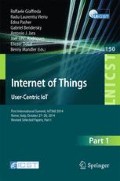Abstract
Recent advances, increasing affordability and popularity of Internet of Things (IoT) technologies are opening exciting new ways of interaction and sensing for mobile device users. Furthermore, the great acceptance of smart mobile devices in our daily lives makes possible various ludic experiences, which could be greatly improved with IoT technologies. This new setting opens many opportunities for design and development of Pervasive Games for the IoT. In this work, we propose a palette of canonic interaction models and gamification tactics that can be combined for the design of new Pervasive IoT Game experiences. Subsequently, we present the methodology and results of a validation interview regarding our model with experienced game designers. Finally, we present a case study for a Pervasive IoT Game, also giving an overview of our middleware for mobile communication as well as its extension for IoT, discussing the possibilities of implementing new Pervasive IoT Games using it.
Access this chapter
Tax calculation will be finalised at checkout
Purchases are for personal use only
Notes
- 1.
List of devices as of August-2014 at: http://www.bluetooth.com/Pages/Bluetooth-Smart-Devices.aspx.
- 2.
Texas Instruments, CC2541 Sensor Tags, April 2013. More information at: http://www.ti.com/lit/ml/swru324b/swru324b.pdf.
- 3.
According to eMarketer: http://www.emarketer.com/Article/Smartphone-Users-Worldwide-Will-Total-175-Billion-2014/1010536.
- 4.
More information can be found in the Game Design and Interaction Analysis at http://www.lac-rio.com/projects/pervasive-iot-games.
- 5.
The model of the interview, proposed interactive and gamification elements, full results and interview transcripts can be also accessed at http://www.lac-rio.com/projects/pervasive-iot-games.
- 6.
As was commented previously, the full and uncommented results of the interviews can be found at the LAC website, at the footnotes on the last page.
- 7.
More information at http://www.lac-rio.com/projects.
- 8.
Accessible at http://www.lac-rio.com/software.
- 9.
A universally unique identifier is an identifier standard used in software construction, standardized by the Open Software Foundation as part of the Distributed Computing Environment: http://en.wikipedia.org/wiki/Universally_unique_identifier.
References
Perkins, E.: Gartner Group Getting Past the Word Games to Secure the Internet of Things. http://blogs.gartner.com/earl-perkins/2014/03/05/getting-past-the-word-games-to-secure-the-internet-of-things/ (2014). Accessed 4 July 2014
Montola, M.: Exploring the edge of the magic circle: defining pervasive games. In: Proceedings of DAC, p. 103, December 2005
Hodson, H.: Google’s ingress game is a gold mine for augmented reality. New Sci. (1971) 216(2893), 19 (2012). doi:10.1016/S0262-4079(12)63058-9
Magerkurth, C., Cheok, A.D., Mandryk, R.L., Nilsen, T.: Pervasive games: bringing computer entertainment back to the real world. Comput. Entertainment (CIE) 3(3), 4 (2005)
Stenros, J., Montola, M., Mäyrä, F.: Pervasive games in ludic society. In: Proceedings of the 2007 Conference on Future Play, pp. 30–37. ACM, November 2007
Wetzel, R.: A case for design patterns supporting the development of mobile mixed reality games. In: Second Workshop on Design Patterns in Games (2013)
Antoniou, V., Schlieder, C.: Participation patterns, VGI and gamification. In: AGILE 2014 – Castellón, 3–6 June 2014
Ballagas, R., Kuntze, A., Walz, S.P.: Gaming tourism: lessons from evaluating REXplorer, a pervasive game for tourists. In: Indulska, J., Patterson, D.J., Rodden, T., Ott, M. (eds.) PERVASIVE 2008. LNCS, vol. 5013, pp. 244–261. Springer, Heidelberg (2008)
Deterding S., Sicart M., Nacke L., O’Hara, K., Dixon, D.: Gamification: using game-design elements in non-gaming contexts. In: CHI 2011 Extended Abstracts on Human Factors in Computing Systems (CHI EA 2011), pp. 2425–2428. ACM, New York, NY, USA, (2011). doi:10.1145/1979742.1979575
Endler M., Baptista G., David L., Vasconcelos R., Malcher M., Pantoja V., Pinheiro V., Viterbo J.: ContextNet: context reasoning and sharing middleware for large-scale pervasive collaboration and social networking. In: Proceedings of the Workshop on Posters and Demos Track (PDT 2011), Article 2, p. 2. ACM, New York, NY, USA (2011). doi:10.1145/2088960.2088962
David, L., Vasconcelos, R., Alves, L., André, R., Endler, M.: A DDS-based middleware for scalable tracking, communication and collaboration of mobile nodes. J. Internet Serv. Appl. 4(1), 1–15 (2013). doi:10.1186/1869-0238-4-16
OMG: Data Distribution Service Portal. http://portals.omg.org/dds/. Accessed June 2014
Silva, L.D., Roriz, M., Endler, M.: MR-UDP: Yet another reliable user datagram protocol, now for mobile nodes, Monografias em Ciência da Computação, nr. MCC 06/13, Departamento de Informática, PUC-Rio (2013). ISSN 0103-9741
Endler, M. et al.: ContextNet reaches out to the Internet of Things. http://www.lac-rio.com/news/contextnet-reaches%C2%A0out-the%C2%A0internet-of%C2%A0things (2014). Accessed 4 Aug 2014
Talavera, L.E., Endler, M., Vasconcelos, I., Vasconcelos, R.,Cunha, M., Silva, F.S.: The Mobile Hub Concept: Enabling applications for the Internet of Mobile Things, Monografias em Ciência da Computação, nr. MCC 04/14, Departamento de Informática, PUC-Rio (2014). ISSN 0103-9741
Duan, J., Gao, D., Yang, D., Foh, C.H., Chen, H.H.: An energy-aware trust derivation scheme with game theoretic approach in wireless sensor networks for IoT applications. IEEE Internet Things J. 1(1), 58–69 (2014). doi:10.1109/JIOT.2014.2314132
Acknowledgements
We acknowledge the partial financial support through fostering scholarship from CNPQ, process no. 153910/2013-5.
Author information
Authors and Affiliations
Corresponding author
Editor information
Editors and Affiliations
Rights and permissions
Copyright information
© 2015 Institute for Computer Sciences, Social Informatics and Telecommunications Engineering
About this paper
Cite this paper
MacDowell, A., Endler, M. (2015). Internet of Things Based Multiplayer Pervasive Games: An Architectural Analysis. In: Giaffreda, R., et al. Internet of Things. User-Centric IoT. IoT360 2014. Lecture Notes of the Institute for Computer Sciences, Social Informatics and Telecommunications Engineering, vol 150. Springer, Cham. https://doi.org/10.1007/978-3-319-19656-5_19
Download citation
DOI: https://doi.org/10.1007/978-3-319-19656-5_19
Published:
Publisher Name: Springer, Cham
Print ISBN: 978-3-319-19655-8
Online ISBN: 978-3-319-19656-5
eBook Packages: Computer ScienceComputer Science (R0)

